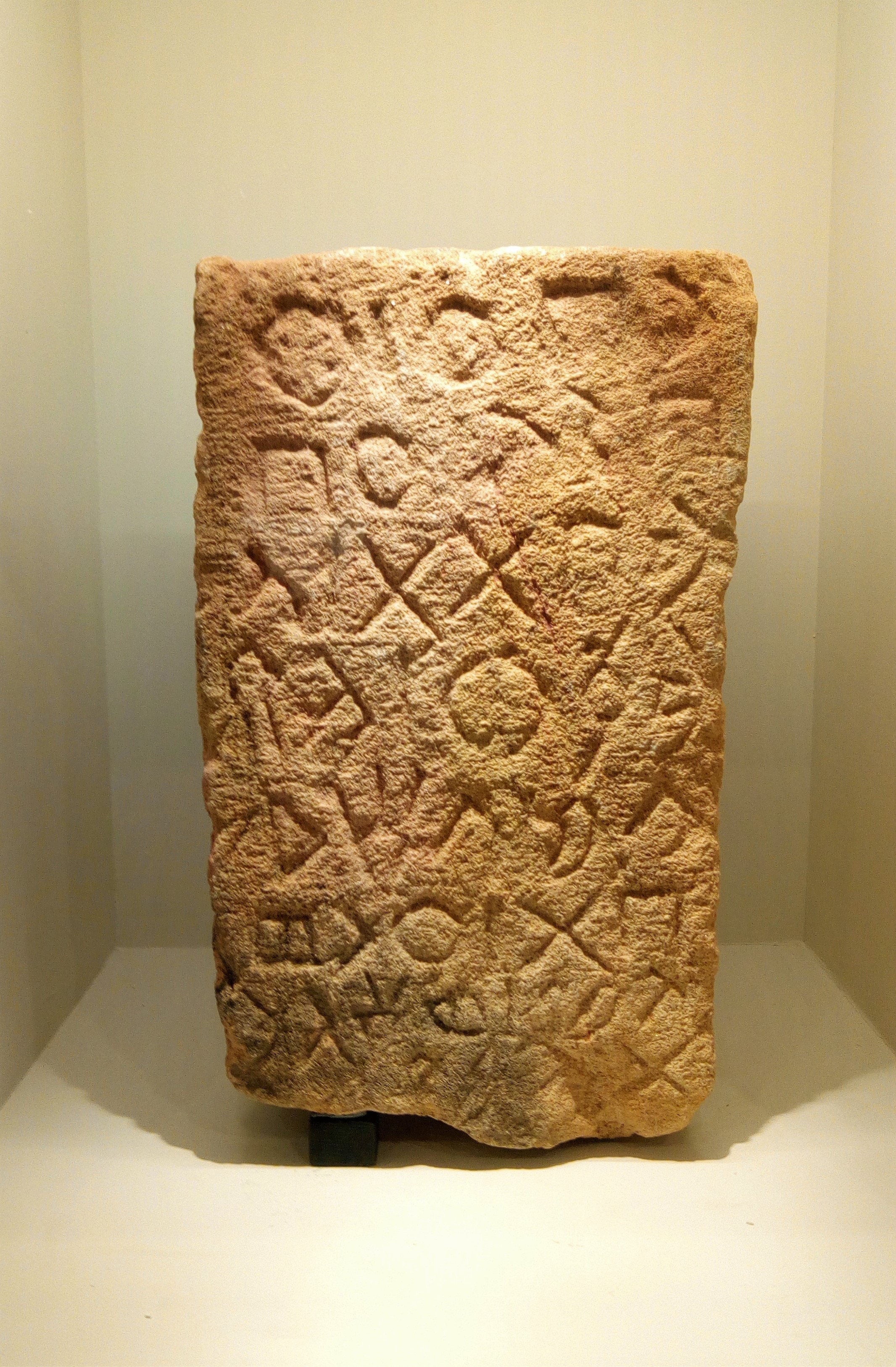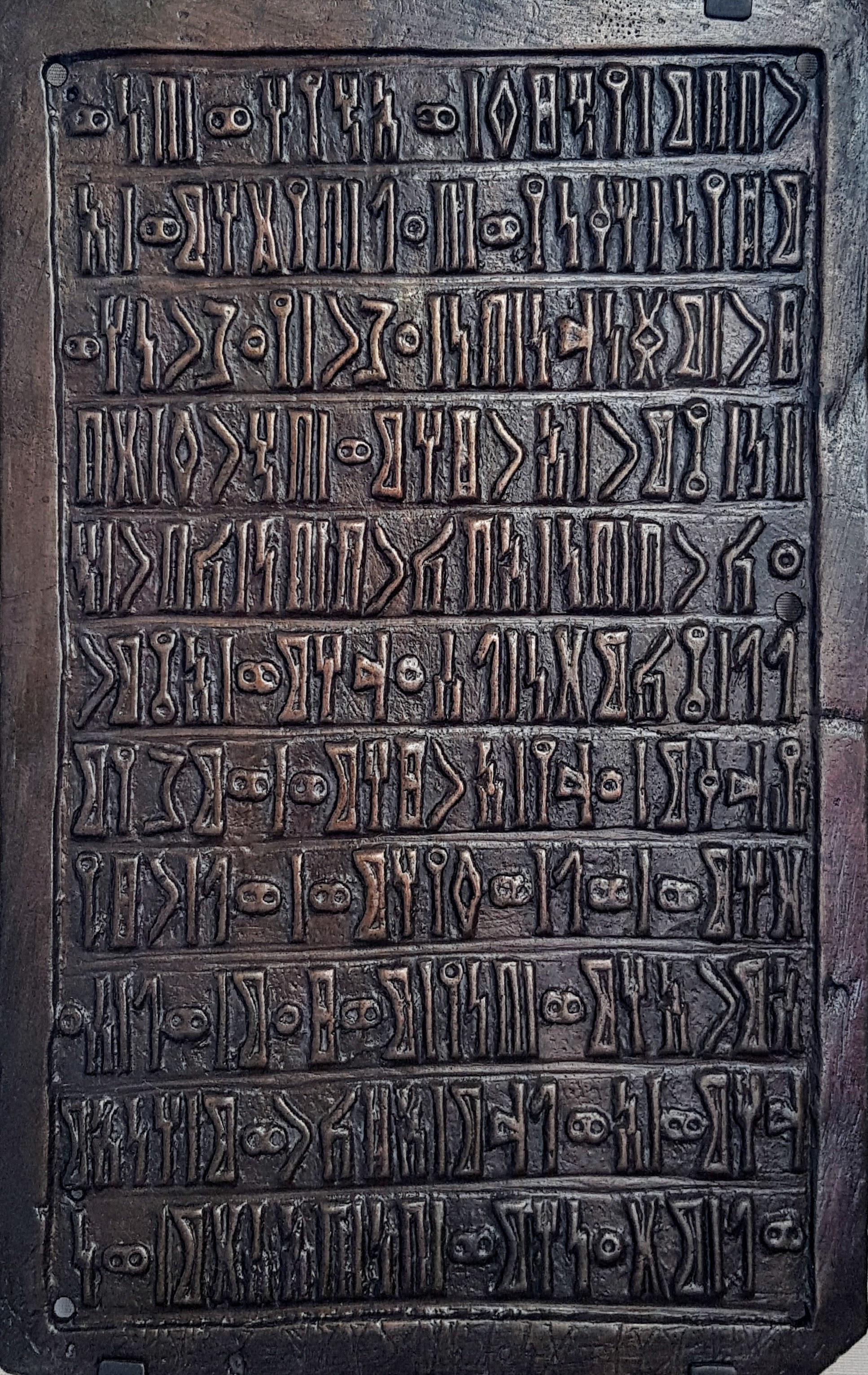|
Minaean Language
The Minaean language (also Minaic, Madhabaic or Madhābic) was an Old South Arabian or Ṣayhadic language spoken in Yemen in the times of the Old South Arabian civilisation. The main area of its use may be located in the al-Jawf region of North-East Yemen, primarily in the Wādī Madhāb. Most of texts in this language were composed by the Minaeans, but the other civil-temple communities of the Wādī Madhāb (Nashshan, Kaminahu, Ḥaram, and Inabba') also used it as a literary medium. History The earliest Minaean inscriptions are contemporary with the earliest Sabaean ones, i.e. the 8th century BCE, though they are less numerous, and come from the cities along Wadi Madhaab, to the north-east of Ma'rib. Minaean trading posts, and Minaean inscriptions are also found outside South Arabia, as in the ancient oasis of Dēdan (the present day Al-'Ula in Saudi Arabia), and even on the Greek island of Delos and in Egypt. Minaean seems to disappear as a written language about the end ... [...More Info...] [...Related Items...] OR: [Wikipedia] [Google] [Baidu] |
Yemen
Yemen (; ar, ٱلْيَمَن, al-Yaman), officially the Republic of Yemen,, ) is a country in Western Asia. It is situated on the southern end of the Arabian Peninsula, and borders Saudi Arabia to the Saudi Arabia–Yemen border, north and Oman to the Oman–Yemen border, northeast and shares maritime borders with Eritrea, Djibouti, and Somalia. Yemen is the second-largest Arabs, Arab sovereign state in the peninsula, occupying , with a coastline stretching about . Its constitutionally stated Capital city, capital, and largest city, is Sanaa. As of 2021, Yemen has an estimated population of some 30.4 million. In ancient times, Yemen was the home of the Sabaeans, a trading state that included parts of modern-day Ethiopia and Eritrea. Later in 275 AD, the Himyarite Kingdom was influenced by Judaism. Christianity arrived in the fourth century. Islam spread quickly in the seventh century and Yemenite troops were crucial in the early Islamic conquests. Several Dynasty, dynasties ... [...More Info...] [...Related Items...] OR: [Wikipedia] [Google] [Baidu] |
Al-'Ula
Al-'Ula ( ar, ٱلْعُلَا '), is a city of the Medina Region in north-western Saudi Arabia. Historically located on the incense route, the city lies within the Governorate of 'Ula ( ar, مُحَافَظَة ٱلْعُلَا, Muḥāfathat Al-ʿUlā), one of seven in the Medina Region, covering an area of . The city is southwest of Tayma and north of Medina. The city (municipality) covers . The population of the city is 5,426. Al-'Ula was the capital of the ancient Lihyanites (Dedanites). The governorate contains the first UNESCO World Heritage Site in the Saudi Kingdom, called Hegra (also known as Al-Hijr, or Mada'in Saleh / Mada'in Salih), north of the city. Hegra (Mada'in Salih) was built more than 2,000 years ago by the Nabataeans. Al-'Ula, the ancient walled city, is packed with mud-brick and stone houses. History The walled city of Al-'Ula was founded in the 6th century BC, an oasis in the desert valley, with fertile soil and plenty of water. It was located along ... [...More Info...] [...Related Items...] OR: [Wikipedia] [Google] [Baidu] |
Languages Of Yemen
Yemen (; ar, ٱلْيَمَن, al-Yaman), officially the Republic of Yemen,, ) is a country in Western Asia. It is situated on the southern end of the Arabian Peninsula, and borders Saudi Arabia to the north and Oman to the northeast and shares maritime borders with Eritrea, Djibouti, and Somalia. Yemen is the second-largest Arab sovereign state in the peninsula, occupying , with a coastline stretching about . Its constitutionally stated capital, and largest city, is Sanaa. As of 2021, Yemen has an estimated population of some 30.4 million. In ancient times, Yemen was the home of the Sabaeans, a trading state that included parts of modern-day Ethiopia and Eritrea. Later in 275 AD, the Himyarite Kingdom was influenced by Judaism. Christianity arrived in the fourth century. Islam spread quickly in the seventh century and Yemenite troops were crucial in the early Islamic conquests. Several dynasties emerged in the 9th to 16th centuries, such as the Rasulid dynasty. The coun ... [...More Info...] [...Related Items...] OR: [Wikipedia] [Google] [Baidu] |
Ancient History Of Yemen
The ancient history of Yemen ( South Arabia) is especially important because Yemen is one of the oldest centers of civilization in the Near East. Its relatively fertile land and adequate rainfall in a moister climate helped sustain a stable population, a feature recognized by the ancient Greek geographer Ptolemy, who described Yemen as ''Eudaimon Arabia'' (better known in its Latin translation, ''Arabia Felix'') meaning ''Fortunate Arabia'' or ''Happy Arabia''. Between the eighth century BCE and the sixth century CE, it was dominated by six main states which rivaled each other, or were allied with each other and controlled the lucrative spice trade: Saba', Ma'īn, Qatabān, Hadhramaut, Kingdom of Awsan, and the Himyarite Kingdom. Islam arrived in 630 CE and Yemen became part of the Muslim realm. The centers of the Old South Arabian kingdoms of present-day Yemen lay around the desert area called Ramlat al-Sab'atayn, known to medieval Arab geographers as Ṣayhad. The southern ... [...More Info...] [...Related Items...] OR: [Wikipedia] [Google] [Baidu] |
Andrey Korotayev
Andrey Vitalievich Korotayev (russian: link=yes, Андре́й Вита́льевич Корота́ев; born 17 February 1961) is a Russian anthropologist, economic historian, comparative political scientist, demographer and sociologist, with major contributions to world-systems theory, cross-cultural studies, Near Eastern history, Big History, and mathematical modelling of social and economic macrodynamics. He is currently the Head of the Laboratory for Monitoring of the Risks of Sociopolitical Destabilization at the HSE University in Moscow,http://www.hse.ru/org/hse/cfi/lab_mr/staff and a Senior Research Professor at the Center for Big History and System Forecasting of the Institute of Oriental Studies as well as in the Institute for African Studies of the Russian Academy of Sciences. In addition, he is a senior research professor of the International Laboratory on Political Demography and Social Macrodynamics (PDSM) of the Russian Presidential Academy of National ... [...More Info...] [...Related Items...] OR: [Wikipedia] [Google] [Baidu] |
Perfect Tense
The perfect tense or aspect (abbreviated or ) is a verb form that indicates that an action or circumstance occurred earlier than the time under consideration, often focusing attention on the resulting state rather than on the occurrence itself. An example of a perfect construction is ''I have made dinner.'' Although this gives information about a prior action (the speaker's making of the dinner), the focus is likely to be on the present consequences of that action (the fact that the dinner is now ready). The word ''perfect'' in this sense means "completed" (from Latin ''perfectum'', which is the perfect passive participle of the verb ''perficere'' "to complete"). In traditional Latin and Ancient Greek grammar, the perfect tense is a particular, conjugated-verb form. Modern analyses view the perfect constructions of these languages as combining elements of grammatical tense (such as time reference) and grammatical aspect. The Greek perfect tense is contrasted with the aorist and ... [...More Info...] [...Related Items...] OR: [Wikipedia] [Google] [Baidu] |
Plene
In orthography, a ''plene scriptum'' (; Latin , "fully" and ''scriptum'', plural ''scripta'', " omethingwritten") is a word containing an additional letter, usually one which is superfluous, not normally written in such words, nor needed for the proper comprehension of the word. Today, the term applies mostly to sacred scripture. Examples of ''plene scripta'' appear frequently in classical Hebrew texts, and copyists are obliged to copy them unchanged, to ensure that biblical or other sacred texts are written with universal conformity. The expression ''plene scriptum'' ( ''yater'', "excess"), sometimes simply described in Hebrew as מלא (''malé'', "full"), is often used in contrast with ''defective scriptum'' ( ''ḥaser'', deficient), the latter implying a word in which a letter that is normally present has been omitted. Together, ''plene'' and ''defective scripta'' are sometimes described using the Hebrew phrase "yeter vehaser" (). Implications In the Hebrew Bible, in '' De ... [...More Info...] [...Related Items...] OR: [Wikipedia] [Google] [Baidu] |
Old South Arabian Languages
Old South Arabian (or Ṣayhadic or Yemenite) is a group of four closely related extinct languages spoken in the far southern portion of the Arabian Peninsula. They were written in the Ancient South Arabian script. There were a number of other Old South Arabian languages (e.g. Awsānian), of which very little evidence has survived, however. A pair of possible surviving Sayhadic languages is attested in the Razihi language and Faifi language spoken in far north-west of Yemen, though these varieties of speech have both Arabic and Sayhadic features, and it is difficult to classify them as either Arabic dialects with a Sayhadic substratum, or Sayhadic languages that have been restructured under pressure of Arabic. Classification issues It was originally thought that all four members of this group were dialects of one Old South Arabian language, but in the mid-twentieth century, linguist A.F.L. Beeston finally proved that they did in fact constitute independent languages. The Ol ... [...More Info...] [...Related Items...] OR: [Wikipedia] [Google] [Baidu] |
Delos
The island of Delos (; el, Δήλος ; Attic: , Doric: ), near Mykonos, near the centre of the Cyclades archipelago, is one of the most important mythological, historical, and archaeological sites in Greece. The excavations in the island are among the most extensive in the Mediterranean; ongoing work takes place under the direction of the Ephorate of Antiquities of Cyclades, and many of the artifacts found are on display at the Archaeological Museum of Delos and the National Archaeological Museum of Athens. Delos had a position as a holy sanctuary for a millennium before Olympian Greek mythology made it the birthplace of Apollo and Artemis. From its Sacred Harbour, the horizon shows the three conical mounds that have identified landscapes sacred to a goddess (it is predicted that the deity's name is Athena) - in other sites: one, retaining its Pre-Greek name Mount Cynthus, is crowned with a sanctuary of Zeus. In 1990, UNESCO inscribed Delos on the World Heritage List, citi ... [...More Info...] [...Related Items...] OR: [Wikipedia] [Google] [Baidu] |
Ma'rib
Marib ( ar, مَأْرِب, Maʾrib; Old South Arabian: 𐩣𐩧𐩨/𐩣𐩧𐩺𐩨 ''Mryb/Mrb'') is the capital city of Marib Governorate, Yemen. It was the capital of the ancient kingdom of ''Sabaʾ'' ( ar, سَبَأ), which some scholars believe to be the ancient Sheba of biblical fame. It is about east of Yemen's modern capital, Sanaa, and is in the region of the Sarawat Mountains. In 2005 it had a population of 16,794. However, in 2021, it had absorbed close to a million refugees fleeing the Yemeni Civil War. History Ancient The Sabaean kingdom was based around Marib, with territory in northern Yemen. The Sabaean kings made their capital at Marib, and built great irrigation works such as the Marib Dam, whose ruins are still visible. The Marib Dam supported a flourishing culture for more than a thousand years. They also built castles and temples in the area, notably Awwam and Barran, respectively. Saba was known for dealing in the lucrative frankincense and myrrh t ... [...More Info...] [...Related Items...] OR: [Wikipedia] [Google] [Baidu] |
Semitic Languages
The Semitic languages are a branch of the Afroasiatic language family. They are spoken by more than 330 million people across much of West Asia, the Horn of Africa, and latterly North Africa, Malta, West Africa, Chad, and in large immigrant and expatriate communities in North America, Europe, and Australasia. The terminology was first used in the 1780s by members of the Göttingen school of history, who derived the name from Shem, one of the three sons of Noah in the Book of Genesis. Semitic languages occur in written form from a very early historical date in West Asia, with East Semitic Akkadian and Eblaite texts (written in a script adapted from Sumerian cuneiform) appearing from the 30th century BCE and the 25th century BCE in Mesopotamia and the north eastern Levant respectively. The only earlier attested languages are Sumerian and Elamite (2800 BCE to 550 BCE), both language isolates, and Egyptian (a sister branch of the Afroasiatic family, related to the ... [...More Info...] [...Related Items...] OR: [Wikipedia] [Google] [Baidu] |
Sabaean Language
Sabaean, also known as Sabaic, was an Old South Arabian language spoken between c. 1000 BC and the 6th century AD, by the Sabaeans. It was used as a written language by some other peoples of the ancient civilization of South Arabia, including the Ḥimyarites, Ḥashidites, Ṣirwāḥites, Humlanites, Ghaymānites, and Radmānites. The Sabaean language belongs to the South Arabian Semitic branch of the Afroasiatic language family. Sabaean is distinguished from the other members of the Old South Arabian group by the use of ''h'' to mark the third person, and as a causative prefix; the other languages all use ''s1'' in these cases; Sabaean is therefore called an ''h''-language, and the others ''s''-languages.Norbert Nebes and Peter Stein, "Ancient South Arabian" in ''The Ancient Languages of Syria-Palestine and Arabia''. CUP 2008 Script Sabaean was written in the South Arabian alphabet, and like Hebrew and Arabic marked only consonants, the only indication of vowels being with ... [...More Info...] [...Related Items...] OR: [Wikipedia] [Google] [Baidu] |

.jpg)






